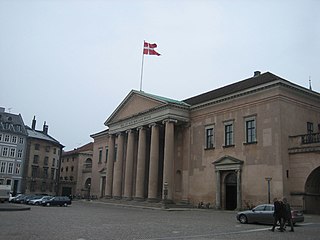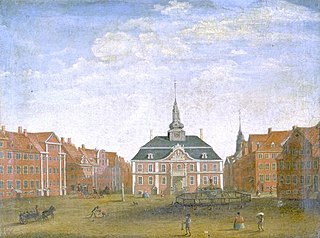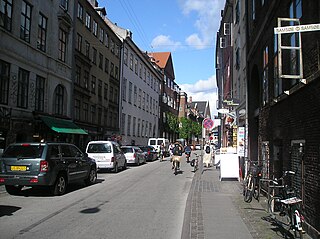
Frederiksborg Castle is a palatial complex in Hillerød, Denmark. It was built as a royal residence for King Christian IV of Denmark-Norway in the early 17th century, replacing an older castle acquired by Frederick II and becoming the largest Renaissance residence in Scandinavia. On three islets in the Slotssøen, it is adjoined by a large formal garden in the Baroque style.

The Round Tower is a 17th-century tower in Copenhagen, Denmark, one of the many architectural projects of Christian IV of Denmark. Built as an astronomical observatory, it is noted for its equestrian staircase, a 7.5-turn helical corridor leading to the platform at the top, and its views over Copenhagen.

City Hall Square is a public square in the centre of Copenhagen, Denmark, located in front of the Copenhagen City Hall. Its large size, central location, and affiliation with the city hall makes it a popular venue for a variety of events, celebrations and demonstrations. It is often used as a central point for measuring distances from Copenhagen.

The Copenhagen Fire of 1728 was the largest fire in the history of Copenhagen, Denmark. It began on the evening of 20 October 1728 and continued to burn until the morning of the 23rd of October 1728. It destroyed approximately 28% of the city and left 20% of the population homeless. The reconstruction lasted until 1737. No less than 47% of the section of the city, which dates back to the Middle Ages, was completely lost, and along with the Copenhagen Fire of 1795, it is the main reason that few traces of medieval Copenhagen can be found in the modern city.

The Church of Our Lady is the cathedral of Copenhagen. It is situated on the Frue Plads public square in central Copenhagen, next to the historic main building of the University of Copenhagen.

The Copenhagen Fire of 1795 started on Friday, 5 June 1795, at or around 3 pm by the Navy's old base south east of Kongens Nytorv on Gammelholm, in the Navy's magazine for coal and timber, the so-called Dellehave. As the workers had already gone home, a considerable length of time passed before efforts to combat the fire started, and out of fear of theft, the fire hydrants had been removed. The people of Holmen also blocked the civilian fire brigade, possibly in the belief that since it was a military area, the military should take care of it.

Copenhagen City Hall is the headquarters of the Copenhagen City Council as well as the Lord mayor of the Copenhagen Municipality, Denmark. The building is situated on City Hall Square in central Copenhagen.

Gammeltorv is the oldest square in Copenhagen, Denmark. With adjoining Nytorv it forms a common space along the Strøget pedestrian zone. While the square dates back to the foundation of the city in the 12th century, most of its buildings were constructed after the Great Fire of 1795 in Neoclassical style. Another dominating feature is the Caritas Well, a Renaissance fountain erected by King Christian IV in 1610.

Nytorv is a public square in the centre of Copenhagen, Denmark. Together with the adjoining Gammeltorv it forms a common space, today part of the Strøget pedestrian zone. The square is dominated by the imposing Neoclassical façade of the Copenhagen Court House, which from 1815-1905 also served as the City Hall.

The Holmen Church is a Parish church in central Copenhagen in Denmark, on the street called Holmens Kanal. First built as an anchor forge in 1563, it was converted into a naval church by Christian IV. It is famous for having hosted the wedding between Margrethe II of Denmark, current queen of Denmark, and Prince Henrik in 1967. It is the burial site of such notabilities as naval heroes Niels Juel and Peter Tordenskjold, and composer Niels Wilhelm Gade, and contains artwork by, among others, Bertel Thorvaldsen and Karel van Mander.

The architecture of Denmark has its origins in the Viking period, richly revealed by archaeological finds. It became firmly established in the Middle Ages when first Romanesque, then Gothic churches and cathedrals sprang up throughout the country. It was during this period that, in a country with little access to stone, brick became the construction material of choice, not just for churches but also for fortifications and castles.

The Copenhagen Court House is a historic building located on Nytorv in Copenhagen, Denmark. Originally built as a combined city hall and courthouse, it now serves as the seat of the District Court of Copenhagen. Inaugurated in 1815, it was built to the design of Christian Frederik Hansen in Neoclassical style.

Amagertorv is a public square in the district of Indre By in central Copenhagen, Denmark. Today it forms part of the Strøget pedestrian zone, and is often described as the most central square in Copenhagen. Second only to Gammeltorv, it is also one of the oldest, taking its name from the Amager farmers who in the Middle Ages came into town to sell their produce at the site.

The Copenhagen University Library in Copenhagen, Denmark, is the main research library of the University of Copenhagen. Founded in 1482, it is the oldest library in Denmark.

Vesterbrogade is the main shopping street of the Vesterbro district of Copenhagen, Denmark. The 1.5 km long street runs from the City Hall Square in the east to Pile Allé in Frederiksberg in the west where it turns into Roskildevej. On its way, it passes Copenhagen Central Station as well as the small triangular square Vesterbros Torv. It is one of four such -bro streets, the other being Nørrebrogade, Østerbrogade and Amagerbrogade.

Bispegården in Copenhagen, Denmark, is the residence and office of the Bishop of Copenhagen. It is located across the street from Copenhagen Cathedral and Frue Plads, on the corner of Nørregade and Studiestræde, in the city centre. Bispetorv, the small square next to it, is named after the building.

A new, fourth City Hall in Copenhagen, Denmark, was built between Gammeltorv and Nytorv in 1728 on the foundations of its predecessor which had been destroyed in the first Great Fire of Copenhagen earlier that same year. In 1795 it was itself destroyed in the second Great Fire of Copenhagen and later replaced by the new combined city hall and courthouse at Nytorv which was completed in 1815.

The Trinitatis Church is located in central Copenhagen, Denmark. It is part of the 17th century Trinitatis Complex, which includes the Rundetårn astronomical observatory tower and the Copenhagen University Library, in addition to the church. Built in the time of Christian IV, the church initially served the students of Copenhagen University. It is situated at the corner of Landemærket and Købmagergade. The interior was seriously damaged in the fire of 1728 but was rebuilt in 1731.

Nørregade is a street in central Copenhagen, Denmark, linking Gammeltorv in the south with Nørre Voldgade in the north. Landmarks in the street include Church of Our Lady, Bispegården, St. Peter's Church and Folketeatret.

Studiestræde is a street in central Copenhagen, Denmark, running from Bispetorv on Nørregade in the northeast to Axeltorv in the southwest. The oldest section of the street, between Nørregade and Vester Voldgade, is part of Copenhagen's Latin Quarter and is home to many small shops, galleries and cafés. Most of the buildings date from the years after the Copenhagen Fire of 1795. The rest of the street dates from an extension in the second half of the 19th century. It is bisected by H. C. Andersens Boulevard and is home to the music venue Pumpehuset.






















